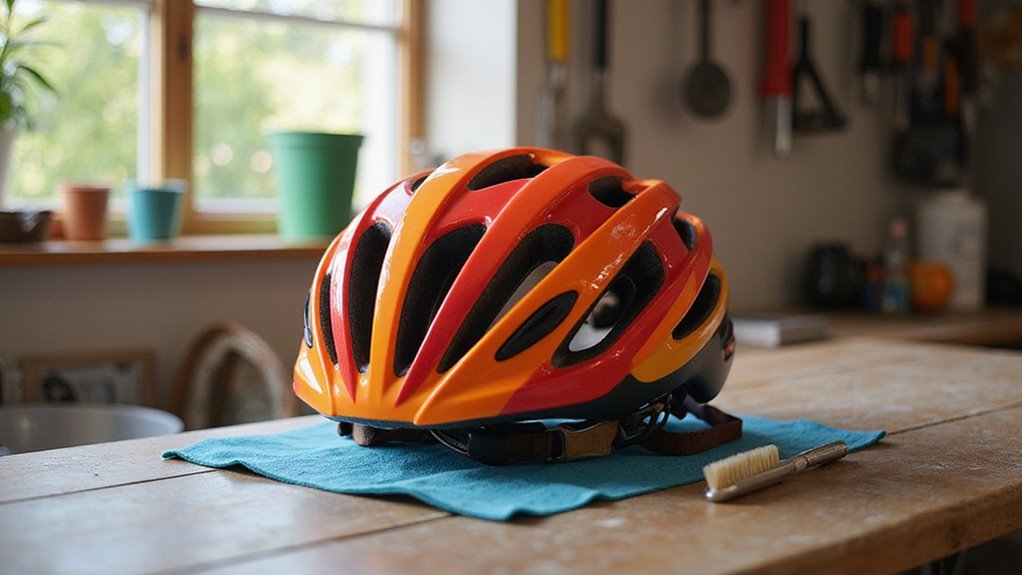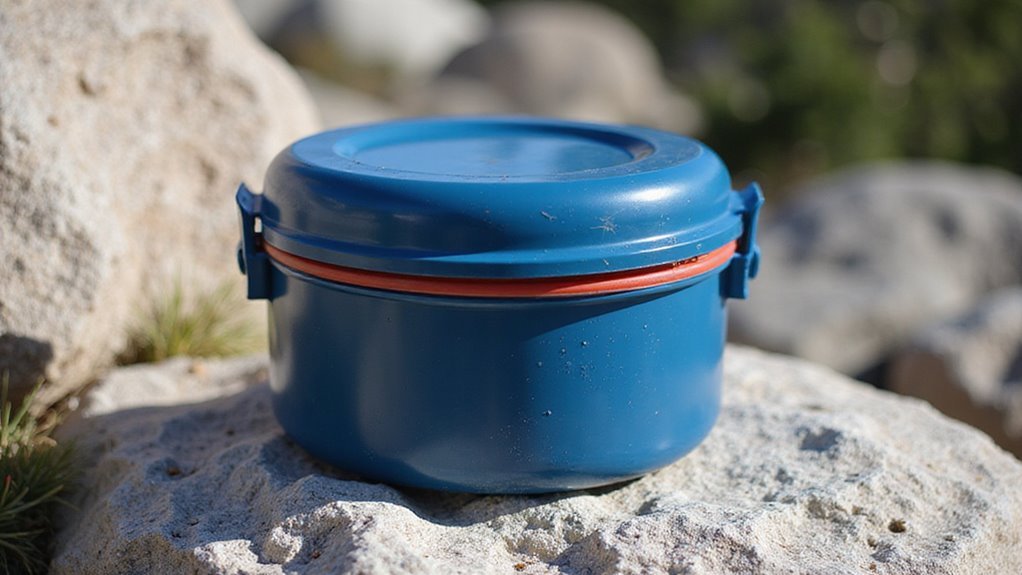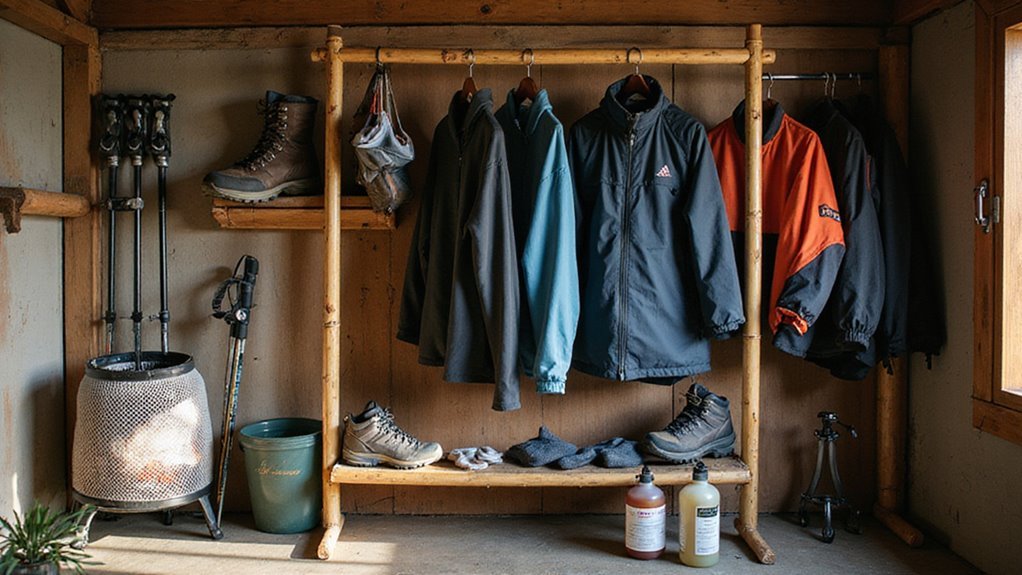Like a surgeon’s instruments or a mechanic’s tools, our hiking gear demands meticulous care to perform when we need it most. We’ll walk you through the essentials of maintaining every piece of equipment in your arsenal – from first aid kits to tent poles. Let’s face it: gear failure in the backcountry isn’t just inconvenient, it’s potentially dangerous. Stick with us to master the maintenance protocols that separate casual hikers from true wilderness professionals.
Essential Gear Inspection Protocols

Before you set foot on any trail, we’ve got to tackle the make-or-break task of gear inspection.
Let’s start with the critical stuff – your first aid kit needs fresh supplies and nothing expired. Check those water filters and containers; they’re your lifeline out there.
Now, inspect every inch of your equipment. We’re talking seams, zippers, and fabric on tents and packs.
Don’t skip the footwear – worn soles or loose stitching spell trouble miles from civilization. Look for holes, tears, or any sign your gear’s giving up.
Trust us, finding problems at home beats discovering them on the trail. Additionally, make sure to check zippers and hardware regularly to prevent unexpected failures that could compromise your gear.
Cleaning and Storage Best Practices
Proper cleaning and storage make the difference between gear that lasts years and gear that fails when you need it most.
Let’s tackle this systematically.
Start with sleeping gear – air out bags and quilts completely before storage. Mildew’s your enemy here.
For tents and tarps, hang them up until bone-dry. No shortcuts.
Don’t neglect your cooking kit. Scrub those pots clean – food residue attracts unwanted visitors.
Check fuel canisters for expiration dates and store them safely.
Finally, inspect everything post-hike. Remove debris from packs, check for damage. Regular maintenance extends the lifespan of the backpack and ensures it’s ready for your next adventure.
Trust us, these cleaning and storage habits will save you money and headaches.
Weather Protection and Waterproofing

When your life depends on staying dry in the backcountry, you can’t afford to neglect weather protection. We’ll show you how to keep water at bay through proper maintenance.
Check your gear before every trip. Look for leaks, loose seams, and failing zippers. If water stops beading on fabric surfaces, it’s time to reapply DWR treatment. Always pack a gear repair kit for emergency fixes. Remember that waterproof rating systems can help you choose the right gear for your adventures.
Test everything in wet conditions before heading out. Layer properly, and don’t forget dry bags for sensitive equipment.
Keep tabs on weather forecasts and plan escape routes. Trust us – you’ll thank yourself when the storm hits.
Equipment Repair Techniques
Mastering field repairs can make the difference between a minor setback and a trip-ending disaster.
We’ll teach you essential repair techniques to handle common wear and tear issues on the trail.
Keep tenacious tape handy for quick fixes on packs and stuff sacks. For tents, seal leaky seams with repair kits and replace broken pegs immediately.
When your rain gear stops beading water, it’s time to reapply DWR coating. Don’t forget to backflush those water filters – calcium buildup kills flow rates fast.
Always carry the right patch kits for sleeping pads and follow manufacturer specs for stove repairs. No exceptions. Additionally, knowing how to patch holes and tears can save your gear from significant damage on the trail.
Safety Equipment Maintenance

Regular inspection of safety equipment isn’t just good practice – it’s your lifeline in the backcountry.
We’re talking about methodically checking your first aid kit before each trek, replacing expired supplies and replenishing depleted items.
Don’t forget those critical personal safety tools – test your flashlight batteries, verify your whistle works, and confirm bear spray hasn’t expired.
Let’s be blunt: knowing how to use this gear matters as much as having it.
Practice those first aid procedures, memorize emergency contacts, and drill response scenarios with your group.
When things go sideways on the trail, you’ll thank yourself for this diligence.
Navigation Tools and Electronics Care
Since your life often depends on reliable navigation, let’s get serious about caring for these critical tools.
We’ll keep it simple: verify your maps and compass before every hike, and always pack both digital and physical navigation backups. Don’t trust your life to dead batteries.
Keep those electronics clean and functional. Wipe down GPS screens, camera lenses, and displays regularly.
Your headlamp needs fresh batteries and a quick test before each trek. And here’s a pro tip: establish a pre-hike charging routine for all devices, including power banks.
Modern tools fail. Redundancy saves lives.
Food Storage System Upkeep

Just like your navigation tools protect you from getting lost, proper food storage keeps both you and wildlife safe on the trail. Let’s nail down the essentials of maintaining your food storage system with military precision.
| Task | Frequency | Critical Points |
|---|---|---|
| Container Check | Post-trip | Inspect seals, locks |
| Sanitization | Monthly | Scrub, disinfect, dry |
| Inventory | Pre-trip | Pack extra, verify stock |
Check containers after every adventure – no exceptions. Pack extra bags for redundancy. Your system’s only as good as its weakest seal. Clean thoroughly monthly, and always maintain a dedicated trash bag. Remember: proper storage isn’t just about freshness – it’s about trail ethics and wildlife safety.
Hydration System Management
Clean water systems aren’t optional for backcountry survival – they’re your lifeline on the trail.
Let’s get serious about maintenance: backwash those water filters when flow drops below 1L/minute, and watch for calcium buildup. It’s non-negotiable.
Store your water bottle and bladders in cool, dry spaces when you’re home.
Trust us, sunlight plus moisture equals unwanted biology experiments.
Grab a Platypus Cleaning Kit and sanitize after every adventure – no exceptions.
Always pack backup purification.
When your primary filter fails (and it will), you’ll thank us for this reminder.
Double systems, zero compromises. Incorporating regular cleaning routines is essential for maintaining the hygiene of hydration systems.
Clothing and Footwear Preservation

Proper gear preservation starts with your trail clothing and footwear fundamentals.
We’re talking about keeping your gear battle-ready through regular inspection and maintenance. Check those seams, patch those holes, and don’t ignore signs of wear – your comfort depends on it.
Your footwear’s crying for attention after every hike. Clean it, dry it, store it right.
Trail runners showing wear? Replace them. We’re not messing around with compromised traction or support.
Let’s talk materials: moisture-wicking fabrics are your friends. Regularly inspect and adjust straps to ensure even weight distribution and comfort.
Keep everything in a cool, dry spot – sunlight’s the enemy here.
Trust us, proper storage equals longer-lasting gear.
Seasonal Gear Transition Steps
As changing seasons demand different gear setups, we’ve got to nail our shift process with military precision.
Let’s tackle this systematically: inspect every piece of gear for wear, clean and waterproof items that need attention, and organize our storage spaces like we mean it.
Smart maintenance means waterproofing tents when water stops beading, replenishing depleted supplies, and ruthlessly inventorying everything we’ve got.
We’re checking first aid kits, fire starters, and hygiene supplies.
Don’t forget that sleeping bag you stuffed away last fall – it needs love too.
Remember: organized gear equals organized adventures. Additionally, ensure your gear is stored in a cool and dry place to prevent damage and extend its lifespan.
Frequently Asked Questions
What Does Every Hiker Need?
We’ll need hiking essentials including navigation tools, first aid supplies, proper footwear, weather-appropriate clothing, and gear organization solutions like a reliable backpack for carrying water and emergency items.
How Do You Take Care of Outdoor Gear?
We’ll keep our gear clean after each use, store equipment in dry places, and regularly inspect for damage. Let’s maintain our repair kits and guarantee we’re cleaning hydration systems properly.
What Is Something a Hiker Should Always Have Before Going on His First Hike?
Like a scout’s motto, we’ll guide you through hiking essentials for your first hike. We always need water, navigation tools, proper footwear, weather-appropriate clothing, and a well-stocked first aid kit.
What Are the 10 Essential Gears in Hiking?
We’ll need these hiking essentials for our safety: navigation tools, first aid kit, knife, fire starter, shelter, water, purification system, extra food, appropriate clothing, and headlamp – all chosen for gear durability.